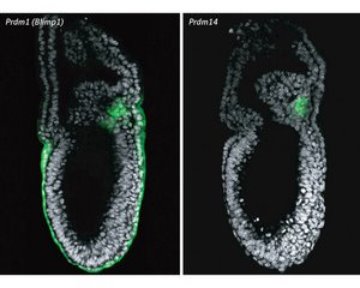Nov. 21, 2008 Research Highlight Biology
Key determinant of sex cells found
A little-known protein plays a crucial role in the production of mammalian eggs and sperm
 Figure 1: The expression of the genes Prdm1 (left) and Prdm14 (right) (shown in green) on day 7.0 of the embryonic development of two transgenic mice. Prdm14 is restricted to where the PGCs will be produced. Reproduced from © 2008 NPG Nature Asia Pacific
Figure 1: The expression of the genes Prdm1 (left) and Prdm14 (right) (shown in green) on day 7.0 of the embryonic development of two transgenic mice. Prdm14 is restricted to where the PGCs will be produced. Reproduced from © 2008 NPG Nature Asia Pacific
RIKEN researchers have uncovered the significant role played by a little-known gene regulator in determining which cells in developing mammalian embryos eventually give rise to sperm and eggs in the adult.
Not only does the work clarify how such germ cells differentiate—a fundamental process of development and heredity—but it also opens the way to the production and culture of primordial germ cells (PGCs) in the laboratory. An abundant and reliable supply of PGCs would facilitate experimentation to investigate the molecular events behind reproduction.
Recent studies in mice have highlighted three key events in the divergence of germ cells from typical body or somatic cells. First, the genes governing somatic cell development are switched off. Second, incipient germ cells re-acquire the properties of stem cells, and third, they are reprogrammed as PGCs.
Earlier work by the RIKEN researchers and others pinpointed the essential part played by the gene regulator Prdm1 in initiating the differentiation of germ cells in mice about 6.25 days after conception. When the gene for Prdm1 is disabled, the development of PGCs stops at a very early stage without proper repression of the genes for somatic cell development.
But researchers at RIKEN’s Center for Developmental Biology in Kobe, led by Mitinori Saitou, were convinced more regulators were involved in PGC formation. They studied the activity of the 16 proteins related to Prdm1 generated by the mouse genome, and found one, Prdm14, specific to PGCs.
The researchers then explored the role of Prdm14 in germ cell development and reported their results recently in Nature Genetics1. By creating transgenic mice in which the expression of Prdm1 and of Prdm14 can be monitored by means of a fluorescent reporter, the researchers showed that by day 7 of development Prdm1 protein was generated not only in germ cells, but over a wide area of extra-embryonic cells, whereas the Prdm14 was limited to the cluster of cells destined to become germ cells (Fig. 1). In fact, Prdm14 was also active for a short while much earlier in development at day 3.5. Using mice in which Prdm14 was disabled, they also found that Prdm14 is required both for the reversion to stem cell status and reprogramming of PGCs.
“We now want to clarify the biochemical mechanism by which these two regulators work,” Saitou says, “and whether they physically interact. These studies should shed light on how this potentially ‘immortal’ cell lineage emerges.”
References
- 1. Yamaji, M., Seki, Y., Kurimoto, K., Yabuta, Y., Yuasa, M., Shigeta, M., Yamanaka, K., Ohinata, Y. & Saitou, M. Critical function of Prdm14 for the establishment of the germ cell lineage in mice. Nature Genetics 40, 1016–1022 (2008). doi: 10.1038/ng.186
